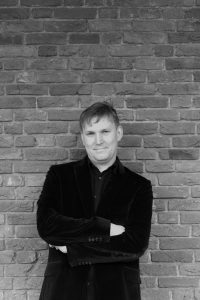Konstantin Wächter

Shortbio
- seit 2021
Neuedition der Bauberichte von Didyma: Wissenschaftliche Mitarbeit im interdisziplinären Forschungsprojekt des FWF und der DFG an der Österreichischen Akademie der Wissenschaften und der Martin-Luther-Universität Halle-Wittenberg zur epigraphischen und bauhistorischen Untersuchung der antiken Bauabläufe am Apollontempel von Didyma, Türkei, Leitung: Dr. Sebastian Prignitz, Prof. Dr. Helga Bumke. - 2020
Denkmaltopographie: Neubearbeitung von Gebiets- und Objekttexten (Heerstraße, Spandauer Berg) für die projektierte Denkmaltopographie Charlottenburg-Westend, Auftraggeber: Landesdenkmalamt Berlin. - 2019-2020
Schloss Charlottenburg, Küchenflügel: Forschungsprojekt der TU Berlin in Kooperation mit der Stiftung Preußische Schlösser und Gärten, Leitung: Prof. Dr.-Ing. Thekla Schulz-Brize und Prof. Dr. Elgin von Gaisberg, wissenschaftliche Betreuung zu bauarchäologischen und bauhistorischen Untersuchungen am Küchenflügel des Schlosses Charlottenburg, Berlin. - 2016-2019
„Identität und Erbe“: Graduiertenkolleg der Deutschen Forschungsgemeinschaft an der TU Berlin und der Bauhaus-Universität, Weimar, Promotionsthema: „Die Berliner Gemeindesynagogen im Deutschen Kaiserreich – Integration und Selbstbehauptung“, Gutachter*Innen Prof. Dr.-Ing. Thekla Schulz-Brize, TU Berlin, Prof. Dr. Hans-Rudolf Meier, Bauhaus-Universität Weimar und Prof. Dr. Stefanie Schüler-Springorum, TU Berlin, Abschluss: Oktober 2020. - 2014-2016
„Das ernestinische Wittenberg“: Gemeinsames Forschungsprojekt der Stiftung Leucorea, der Martin-Luther-Universität Halle-Wittenberg, der Universität Leipzig und der TU Berlin, wissenschaftliche Mitarbeit und bauarchäologische Untersuchung der spätgotischen Fronleichnamskapelle auf dem Kirchhof der Stadtpfarrkirche St. Marien. - seit 2013
„Kulte im Kult“: Forschungsprojekt der Nordrhein-Westfälischen Akademie der Wissenschaften und Künste unter Leitung von Prof. Dr. Helga Bumke, Lehrstuhl für Klassische Archäologie, Martin-Luther-Universität Halle-Wittenberg, bauarchäologische Dokumentation der Grabungskampagnen im extraurbanen Apollonheiligtum von Didyma (Türkei) und bauhistorische Untersuchung der antiken bis neuzeitlichen Baubefunde auf dem Hügel der Kapelle des Agios Georgios. - 2013-2016
Freie Mitarbeit in verschiedenen Büros der Bauforschung in Berlin. - 2013-2014
Schloss auf der Pfaueninsel: Forschungsprojekt der TU Berlin in Kooperation mit der Stiftung Preußische Schlösser und Gärten, Leitung: Prof. Dr.-Ing. Dorothée Sack und Prof. Dr. Elgin von Gaisberg, wissenschaftliche Mitarbeit zu bauarchäologischen und bauhistorischen Untersuchungen des Schlosses auf der Pfaueninsel und seiner wandfesten Ausstattung. - 2011-2012
Technische Universität Berlin, Masterstudium der Denkmalpflege,
Masterarbeit „Berlin-Lichtenberg, Tierpark Friedrichsfelde -Sozialistischer Planzoo
des Kollektivs Graffunder“. - 2007-2011
Freie Mitarbeit in verschiedenen Architekturbüros in Dresden und Berlin. - 2002-2009
Technische Universität Dresden, Diplomstudium der Architektur,
Diplomarbeit: „WohnHaft – Offener Vollzug der JVA Chemnitz“. - 2005-2006
Ecole nationale supérieure d‘architecture de Strasbourg,
Erasmus-Austausch über zwei Semester im Rahmen des Architekturstudiums.
Contact
konstantin.waechter@altertum.uni-halle.de
The Berlin Community Synagogues in the German Empire. Integration and Self-Assertion
At the end of the 19th century, Berlin was not only the capital of a great power that had just been united as a nation, but also an important center of Jewish culture in Europe. The emergence of new synagogue buildings during the imperial period marked the growth of the Berlin community and was framed by negotiation processes between the individual actors – the Jewish religious community, the architects, and the officials of the building authorities. A remarkable change in architectural concepts during the imperial period can be observed. Not only were current fashions in architecture and stylistic training influential in design, but above all social developments and the positioning of the Jewish minority within German society determined the development of various architectural strategies and thus also the built visibility of the community in the public space of the capital. The typological change of Berlin synagogues, which manifested itself in 1910-1912, for example, in the free-standing construction of the community synagogue on Fasanenstraße and clearly distinguished it from the type of courtyard synagogue with a school building on the street side, which had previously been found as a solution to the building task in Berlin, is traced and historicized within the framework of the research work.
What were the experiences of Jewish citizens in German society behind the construction projects of the community synagogues? How did the builders of the synagogues situate themselves within the empire and within their community? What was the significance of the synagogues as visible signs of Jewish culture for an increasingly secular Jewish middle class? Research into the synagogues of the congregation, their development in terms of ground plan, their positioning in urban planning, and their varying richness of form can provide insights into these questions and give us an idea of the complex background behind these elaborate large-scale buildings. The investigations show that the clients and users were just as diverse and heterogeneous as their monumental prayer halls reflected.
Publications
- Konstantin Wächter, Berlin: Authenticity of Former Synagogue Sites – Heritage in the Void, in: Synagogue and Museum, Hrsg. von Katrin Keßler, Ulrich Knufinke, Alexander von Kienlin und Annette Weber, Petersberg 2018, S. 127-130.
- Konstantin Wächter zus. mit Elgin v. Gaisberg, Isabelle Frase, Sandra Reinken und Nora Ullrich, Berlin-Wannsee, Schloss Pfaueninsel – Bauarchäologische und baugeschichtliche Untersuchung, in: Jahrbuch MSD 2012-14, Hrsg. von Dorothée Sack, Berlin 2014, S. 64.
- Konstantin Wächter, Berlin-Lichtenberg, Tierpark Friedrichsfelde – Sozialistischer Planzoo des Kollektivs Graffunder, in: Jahrbuch MSD 2011 – 2013, Hrsg. von Dorothée Sack, Berlin 2013, S. 79.